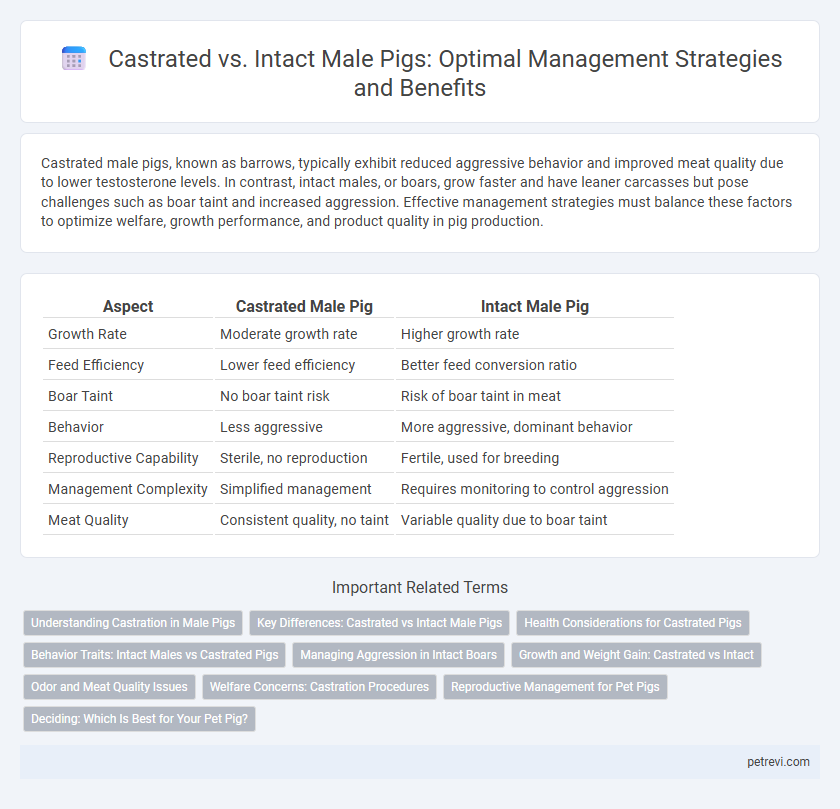Castrated male pigs, known as barrows, typically exhibit reduced aggressive behavior and improved meat quality due to lower testosterone levels. In contrast, intact males, or boars, grow faster and have leaner carcasses but pose challenges such as boar taint and increased aggression. Effective management strategies must balance these factors to optimize welfare, growth performance, and product quality in pig production.
Table of Comparison
| Aspect | Castrated Male Pig | Intact Male Pig |
|---|---|---|
| Growth Rate | Moderate growth rate | Higher growth rate |
| Feed Efficiency | Lower feed efficiency | Better feed conversion ratio |
| Boar Taint | No boar taint risk | Risk of boar taint in meat |
| Behavior | Less aggressive | More aggressive, dominant behavior |
| Reproductive Capability | Sterile, no reproduction | Fertile, used for breeding |
| Management Complexity | Simplified management | Requires monitoring to control aggression |
| Meat Quality | Consistent quality, no taint | Variable quality due to boar taint |
Understanding Castration in Male Pigs
Castration in male pigs, commonly performed to reduce aggressive behavior and improve meat quality by preventing boar taint, involves surgically removing the testes before sexual maturity. Intact males typically exhibit stronger, more dominant behaviors and produce leaner meat with a risk of unpleasant odors, while castrated males provide a more consistent and desirable pork flavor profile. Understanding the physiological and economic impacts of castration is essential for effective swine management and welfare practices.
Key Differences: Castrated vs Intact Male Pigs
Castrated male pigs, commonly known as barrows, exhibit reduced aggressive behavior and eliminate boar taint, enhancing meat quality compared to intact males, or boars. Intact males typically grow faster and convert feed more efficiently but pose challenges in handling due to increased libido and aggression. Effective management strategies must balance these differences to optimize productivity and animal welfare.
Health Considerations for Castrated Pigs
Castrated male pigs, or barrows, generally exhibit improved health outcomes such as reduced aggression and lower risk of injuries compared to intact males, or boars. Castration decreases the incidence of boar taint, a condition affecting meat quality, and reduces aggressive behaviors that can lead to wounds and infections. However, castration may increase susceptibility to obesity and metabolic disorders, necessitating careful dietary and health management.
Behavior Traits: Intact Males vs Castrated Pigs
Intact male pigs exhibit increased aggression and territorial behaviors compared to castrated males, often leading to more frequent fights and dominance displays. Castrated pigs tend to show calmer demeanor, reduced mounting and biting behaviors, contributing to easier group management and less stress-related injuries. These behavioral differences significantly impact housing strategies, welfare considerations, and production outcomes in swine operations.
Managing Aggression in Intact Boars
Managing aggression in intact boars requires strategic environmental enrichment and consistent handling practices to reduce stress and dominance behaviors. Providing sufficient space, secure pen design, and regular human interaction can mitigate aggressive outbreaks. Implementing these techniques improves animal welfare and farm safety while maintaining natural boar characteristics.
Growth and Weight Gain: Castrated vs Intact
Castrated male pigs generally exhibit slower growth rates and lower feed efficiency compared to intact males due to hormonal changes affecting metabolism and muscle development. Intact males typically achieve higher weight gain and leaner carcasses, driven by testosterone's anabolic effects. However, intact males may present challenges such as aggression and boar taint, which can impact meat quality and management practices.
Odor and Meat Quality Issues
Castrated male pigs typically exhibit reduced boar odor, a key factor affecting consumer acceptance and meat quality. Intact males may produce higher levels of androstenone and skatole, compounds responsible for unpleasant odors in pork. Managing these odor-causing substances is critical to ensure desirable meat flavor and overall product marketability.
Welfare Concerns: Castration Procedures
Castration of male pigs primarily aims to prevent aggressive behavior and eliminate boar taint, but it raises significant animal welfare concerns due to pain and stress associated with the procedure. Methods such as surgical castration without anesthesia cause acute pain, while immunocastration offers a less painful alternative by using vaccines to suppress testicular function. Welfare-focused management emphasizes minimizing pain through analgesics, anesthetics, or adopting non-invasive alternatives like immunocastration to improve overall pig well-being.
Reproductive Management for Pet Pigs
Castrated male pet pigs exhibit reduced aggressive and territorial behaviors, facilitating easier handling and integration with other animals, while intact males maintain natural reproductive functions important for breeding programs. Reproductive management requires balancing the benefits of castration, such as minimized unwanted breeding and odor control, against preserving genetic diversity in intact males. Monitoring reproductive health and behavior ensures optimal pig welfare and successful breeding outcomes within pet pig populations.
Deciding: Which Is Best for Your Pet Pig?
Choosing between castrated and intact male pigs depends on factors like behavior, health, and intended use. Castration reduces aggressive tendencies and odor issues linked to intact males, making it preferable for pets in home environments. Intact males may exhibit stronger territorial behaviors but retain natural hormone levels that can benefit breeding and certain types of pig management.
Castrated vs Intact for Pig Male Management Infographic

 petrevi.com
petrevi.com